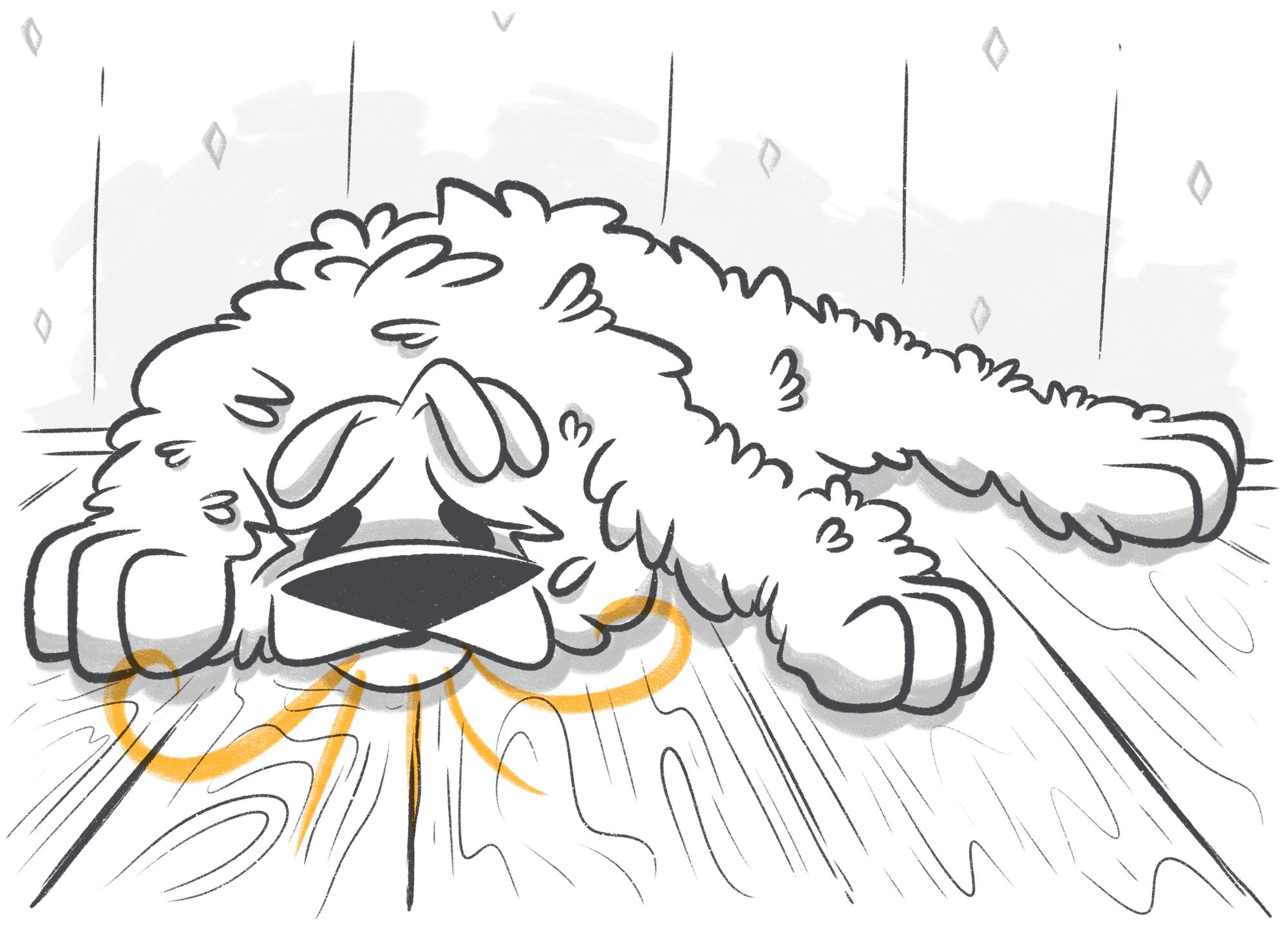Paralysis of the larynx in dogs, also known as laryngeal paralysis, is much more prevalent than diagnosis statistics would lead us to believe. It causes a wide range of vague symptoms and has the potential to be fatal, which is why you should pay close attention to the sounds your pampered pooch makes.
Please allow me to explain why...
Content:
- What is Laryngeal Paralysis
- What Causes Laryngeal Paralysis
- Symptoms of Laryngeal Paralysis in Dogs
- How is Laryngeal Paralysis Treated
- How Can the Emergency Fund Help with Treatment
- FAQ
- Conclusion
What is Laryngeal Paralysis
The larynx in your throat isn’t just for your dog to make noise — barking, growling, etc. The epiglottis connects to the larynx, ensuring food and water go down your pet’s esophagus and not into the trachea (windpipe) and lungs.
Stop Googling - Ask a Real Vet
Contracting and releasing the larynx muscles and cartilage allows easy breathing — a steady, uninterrupted flow of oxygen and carbon dioxide.
When the nerves of the larynx stop working, it becomes paralyzed (hence ‘laryngeal paralysis’) and doesn’t function normally. This interrupts the steady flow of oxygen and carbon dioxide, allows food and water to enter the lungs, and alters your pup’s vocal noises. The vocal cords and muscles either don’t move at all or don’t move enough.
What Causes Laryngeal Paralysis
Experts don’t know what causes this condition in dogs. It’s more common in middle-aged and senior dogs and large or giant dogs, such as Great Danes, Irish Setters, Golden Retrievers, Newfoundlands, and Labradors.
Some breeds are more prone to laryngeal paralysis as a genetic condition from birth, often inherited from parents. These include Dalmatians, Bulldogs, Bouvier des Flandres, Rottweilers, and Siberian Huskies.
Other causes of canine laryngeal paralysis are:
- Chest or neck tumors;
- Injury to the neck, throat, or chest;
- Hypothyroidism;
- Generalized nerve dysfunction (peripheral polyneuropathy);
- Complications following thyroid gland removal or other throat surgeries.
Symptoms of Laryngeal Paralysis in Dogs
The symptoms of laryngeal paralysis aren’t obvious when a dog is resting. When the doggo is in hot temperatures, moves around, exercises, get excited, or feel anxious, however, symptoms become much more obvious.
Laryngeal paralysis symptoms include:
- Changes to bark and other vocal noises;
- Complete loss of ‘voice’;
- Loud panting;
- Exercise and activity avoidance;
- Regurgitating food;
- Difficulty swallowing;
- Vomiting;
- Making choking or gagging noises;
- Difficulty breathing;
- Changes to the color of the gums, mouth, or tongue;
- Coughing.
These are common signs of other canine medical conditions, which makes them tough to diagnose. This is especially the case in mature dogs because the signs and symptoms of laryngeal paralysis are like those of ‘old age.’
It’s helpful to visit your vet with a full list of symptoms, so spend a few moments looking over the footage from your home or [Pet Camera](Petcube Camera) — nothing out-of-the-ordinary. According to VCA Animal Hospitals study, a cough following exertion is the most frequently reported sign.
How is Laryngeal Paralysis Treated
You cannot cure laryngeal paralysis in dogs. Instead, the condition is managed with a combination of different therapies and lifestyle changes.
You can get things started by doing the following:
- Remove pets from direct sunlight and hot temperatures;
- Provide extra fresh water and a fan or air conditioning. This can be facilitated, for example, by using a water fountain;
- Keep anxiety and stress to a minimum;
- Temporarily remove the collar, harness, or other constriction or pressure around the chest and neck;
- Minimize activities and exercise;
- Avoid exciting or riling up your dog.
A vet will assess the seriousness of the situation before recommending treatments but will often suggest Unilateral Arytenoid Lateralization (UAL) surgery, which uses sutures to permanently keep one side open. Half of the larynx is tied back, similar to a curtain tied back.
Other recommended treatments and therapies include:
- Physical therapy;
- Restricted diet for weight loss;
- Medication to reduce stress and anxiety;
- Antibiotics (for aspiration pneumonia);
- Anti-inflammatory medications;
- Sedatives;
- Steroids;
- Intubation (for oxygen);
- Intravenous fluids (for dehydration and high temperatures).
How Can the Emergency Fund Help with Treatment

Laryngeal paralysis can quickly turn into a serious medical emergency after any kind of activity that causes canines to pant, such as drinking or eating. Obstructed airways can develop into respiratory distress, which is fatal if not quickly resolved.
Thankfully, emergency breathing difficulty cases are just one of the things covered by Petcube’s Emergency Fund, a bank-balance-friendly alternative to conventional pet insurance. For less than $1 per day, your pet's medical costs (up to the value of $3,000) could be completely covered.
(And you’d have access to 24/7 veterinary advice and guidance for when you need it the most… even if that is 2:30 in the morning!)
FAQ
Is Laryngeal Paralysis Fatal?
Without treatment, yes, laryngeal paralysis and its complications can be fatal. When laryngeal cartilage fails to open and close normally, dogs are unable to inhale the oxygen they need.
This leads to collapse, serious respiratory distress, and death. Breathing difficulties can also lead to the inhalation of water or food, which in turn can affect the lungs by way of aspiration pneumonia.
How Long Do Dogs with Laryngeal Paralysis Live?
With surgery and/or long-term treatment and care, dogs can live a regular, normal, and healthy life with laryngeal paralysis with no reduction in life expectancy. It isn’t a death sentence, but it will require more vet checkups, emergency appointments, and potential long-term costs.
Should a Dog with Laryngeal Paralysis be Euthanized?
This condition is manageable, so it’s not necessary to euthanize dogs in their initial stages. Later stages, on the other hand, come with significant breathing troubles, which eventually affect all parts of the body.
It can leave your once bouncy and energized pet lethargic and unable to move around, struggling to eat and drink without assistance, and incapable of reaching the back door to alert you to their bathroom needs. Your vet will only advise euthanizing your pet when it is inhumane to keep them alive.
Conclusion
If you notice any changes to the way your dog sounds when they bark, breathe, eat, drink, sleep, or pant, seek veterinary advice. These changes can be short-term, such as with a cold, but they can also be signs of serious, potentially life-threatening diseases such as laryngeal paralysis.
When it comes to your furry family members, it’s always better to be safe than sorry. Ignoring this condition is not an option.
Was this article helpful?
Help us make our articles even better









